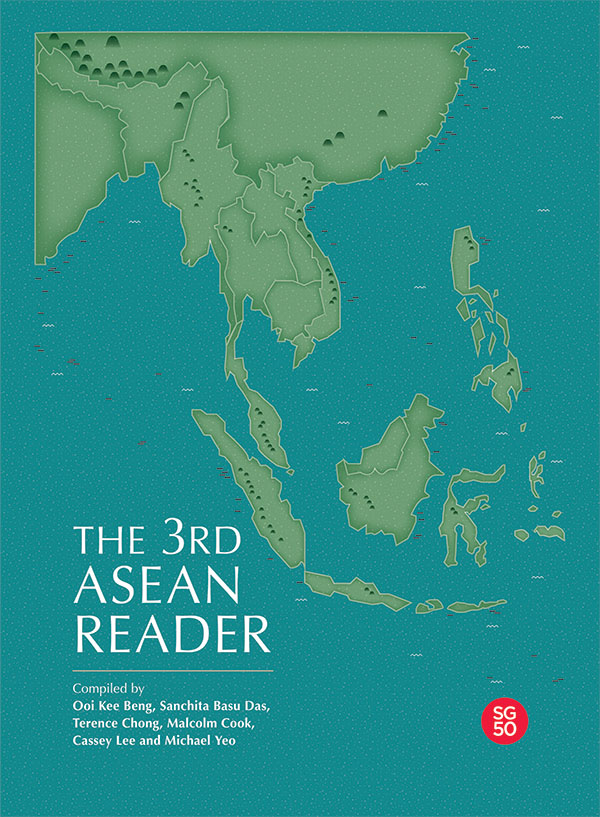Book contents
- Frontmatter
- Contents
- Preface
- Forewords to the First and Second ASEAN Reader: ASEAN: Conception and Evolution
- Forewords to the First and Second ASEAN Reader: ASEAN: The Way Ahead
- Forewords to the First and Second ASEAN Reader: New Challenges for ASEAN
- SECTION I ASEAN: THE LONG VIEW
- SECTION II COUNTRY ANALYSES
- SECTION III COMPARATIVE ANALYSES OF THE REGION
- Southeast Asian Societies
- The Southeast Asian Economy
- Southeast Asian Politics
- SECTION IV INTERNATIONAL DEVELOPMENTS
- SECTION V INSTITUTIONS OF ASEAN
- SECTION VI ASSESSING ASEAN'S INTERNAL POLICIES
- ASEAN Political Security Community
- ASEAN Economic Community
- ASEAN Socio-Cultural Community
- SECTION VII ASSESSING ASEAN'S EXTERNAL INITIATIVES
- ASEAN Processes
- 61 Driving East Asian Regionalism: The Reconstruction of ASEAN's Identity
- 62 Pakistan, SAARC and ASEAN Relations
- 63 Neither Skepticism nor Romanticism: The ASEAN Regional Forum as a Solution for the Asia-Pacific Assurance Game
- 64 ASEAN Plus Three and the Rise of Reactionary Regionalism
- 65 How the East Asia Summit Can Achieve its Potential
- 66 ‘Talking Their Walk’? The Evolution of Defense Regionalism in Southeast Asia
- 67 ASEAN FTAs: State of Play and Outlook for ASEAN's Regional and Global Integration
- 68 Taking ASEAN+1 FTAs Towards the RCEP
- 69 RCEP and TPP: Comparisons and Concerns
- 70 Enhancing the Effectiveness of CMIM and AMRO: Selected Immediate Challenges and Tasks
- ASEAN's Major Power Relations
- SECTION VIII SOUTHEAST ASIA: PERIPHERAL NO MORE
- Bibliography
- The Contributors
- The Compilers
69 - RCEP and TPP: Comparisons and Concerns
from ASEAN Processes
Published online by Cambridge University Press: 22 June 2017
- Frontmatter
- Contents
- Preface
- Forewords to the First and Second ASEAN Reader: ASEAN: Conception and Evolution
- Forewords to the First and Second ASEAN Reader: ASEAN: The Way Ahead
- Forewords to the First and Second ASEAN Reader: New Challenges for ASEAN
- SECTION I ASEAN: THE LONG VIEW
- SECTION II COUNTRY ANALYSES
- SECTION III COMPARATIVE ANALYSES OF THE REGION
- Southeast Asian Societies
- The Southeast Asian Economy
- Southeast Asian Politics
- SECTION IV INTERNATIONAL DEVELOPMENTS
- SECTION V INSTITUTIONS OF ASEAN
- SECTION VI ASSESSING ASEAN'S INTERNAL POLICIES
- ASEAN Political Security Community
- ASEAN Economic Community
- ASEAN Socio-Cultural Community
- SECTION VII ASSESSING ASEAN'S EXTERNAL INITIATIVES
- ASEAN Processes
- 61 Driving East Asian Regionalism: The Reconstruction of ASEAN's Identity
- 62 Pakistan, SAARC and ASEAN Relations
- 63 Neither Skepticism nor Romanticism: The ASEAN Regional Forum as a Solution for the Asia-Pacific Assurance Game
- 64 ASEAN Plus Three and the Rise of Reactionary Regionalism
- 65 How the East Asia Summit Can Achieve its Potential
- 66 ‘Talking Their Walk’? The Evolution of Defense Regionalism in Southeast Asia
- 67 ASEAN FTAs: State of Play and Outlook for ASEAN's Regional and Global Integration
- 68 Taking ASEAN+1 FTAs Towards the RCEP
- 69 RCEP and TPP: Comparisons and Concerns
- 70 Enhancing the Effectiveness of CMIM and AMRO: Selected Immediate Challenges and Tasks
- ASEAN's Major Power Relations
- SECTION VIII SOUTHEAST ASIA: PERIPHERAL NO MORE
- Bibliography
- The Contributors
- The Compilers
Summary
With the Doha Round getting delayed at the multilateral level and the bilateral free trade agreements (FTAs) generating marginal gains for the private sector, mini-lateral arrangements like Regional Comprehensive Economic Partnership (RCEP) and Trans-Pacific Partnership (TPP) are picking up steam, promising to become the next generation of trade liberalisation process.
While it may appear that TPP and RCEP have relatively similar objectives of trade liberalisation and economic integration, the differences are substantive nevertheless. This paper takes a closer look at both these arrangements.
COMPARING RCEP AND TPP
RCEP, driven by ASEAN, is an FTA between ASEAN and ASEAN's FTA partners — Australia-New Zealand, China, South Korea, Japan and India. It is envisaged to be a high-quality and mutually beneficial economic partnership agreement that will broaden and deepen current FTA engagements. It is expected to be concluded by end-2015 and will involve a region accounting for almost half of the global market and about a third of the world's economic output. It is based on an open accession clause and welcomes participation by any ASEAN FTA partner who chooses to participate later.
TPP, on the other hand, is a US-led process and is presented as a “WTO-plus approach”. Around eleven countries (New Zealand, Singapore, Brunei, Chile, the US, Canada, Australia, Peru, Malaysia, Vietnam, Mexico) have already been negotiating TPP for over a year now, although these do not include major powers like China or India. The US has encouraged other APEC countries to join the negotiations, which are set to be concluded by October 2013.
RCEP will be built on ASEAN's experience and is expected to integrate all five of the ASEAN+1 FTAs into a regional economic framework (Basu Das 2012). Being an ASEAN process, it will be guided by the “ASEAN way” where objectives and commitments are driven by a consensus process. RCEP is likely to be more accommodative of the development differences of the member countries, thus providing flexibility and adjusting mechanisms in reaching the common end-goals. In addition to liberalizing trade in goods, services and investment, it will pay more attention to physical, institutional and people-to-people connectivity and to narrowing development gaps and will be built in response to new developments, such as the emerging international production networks.
Information
- Type
- Chapter
- Information
- The 3rd ASEAN Reader , pp. 362 - 366Publisher: ISEAS–Yusof Ishak InstitutePrint publication year: 2015
